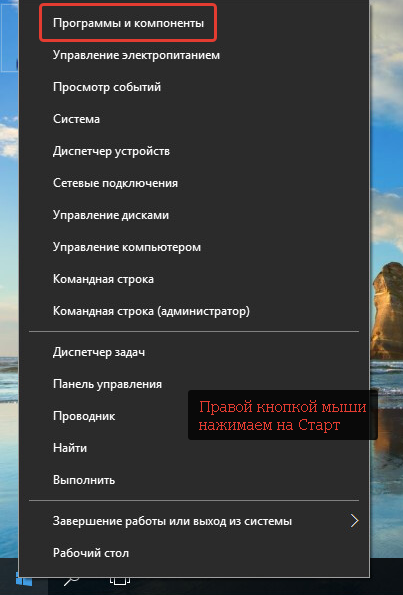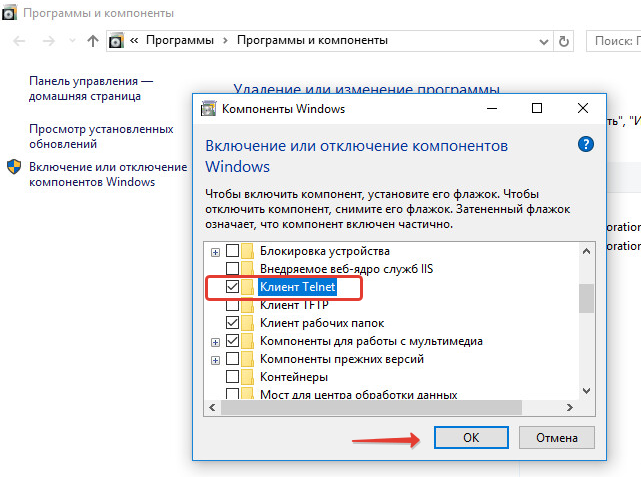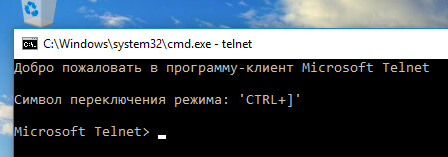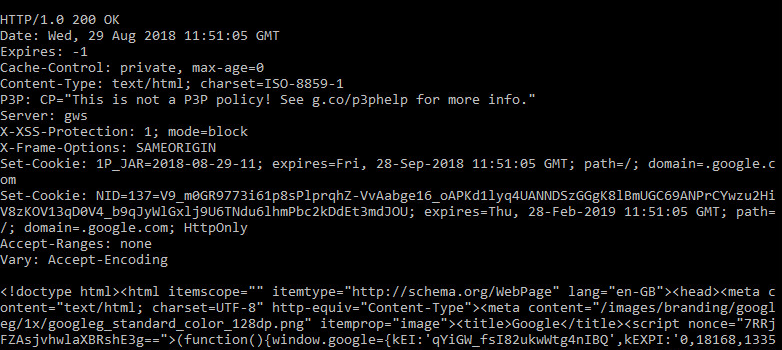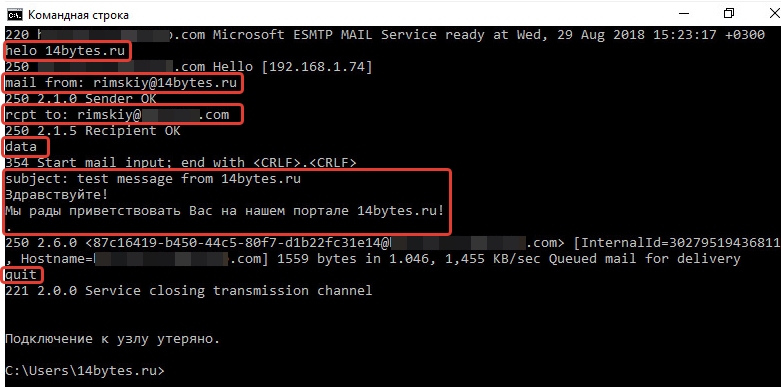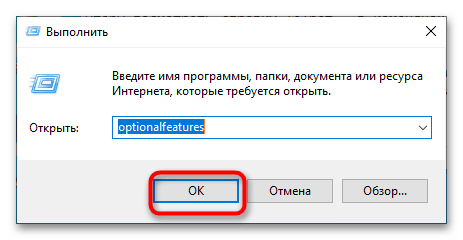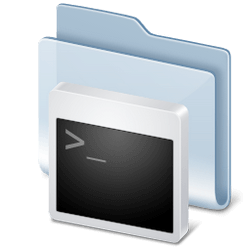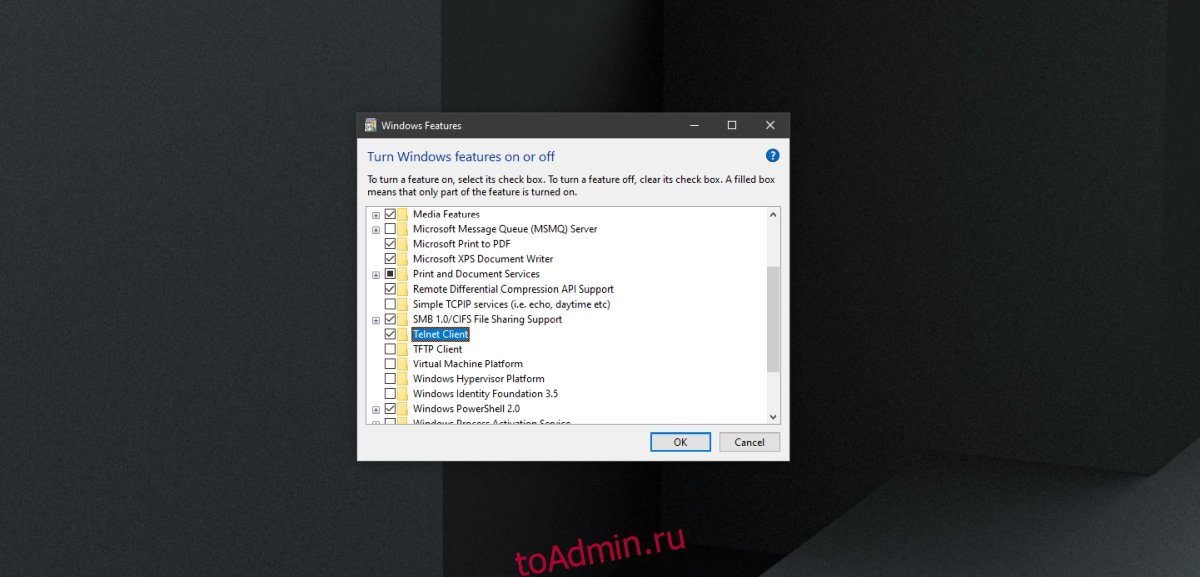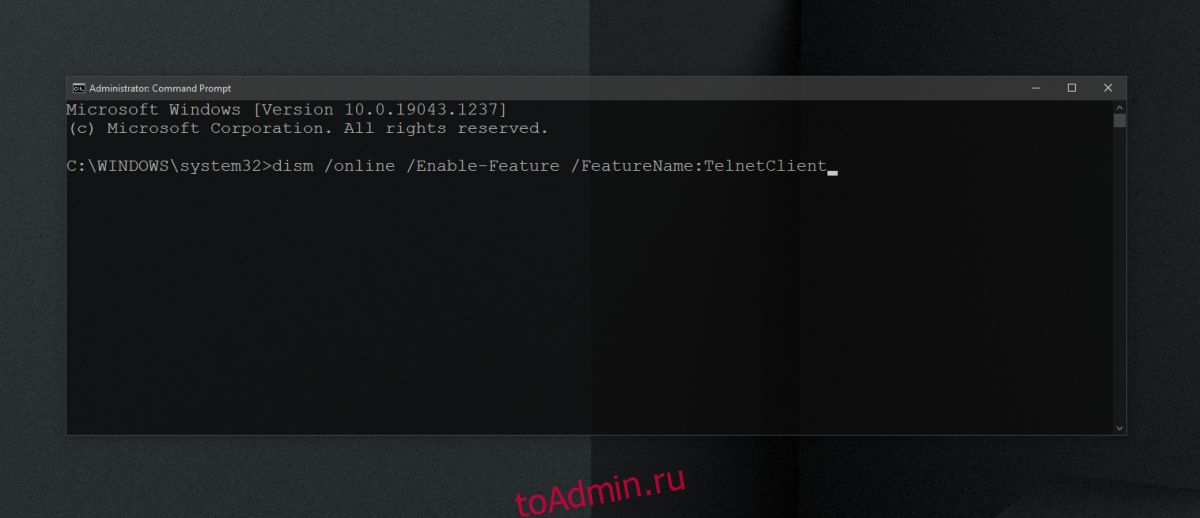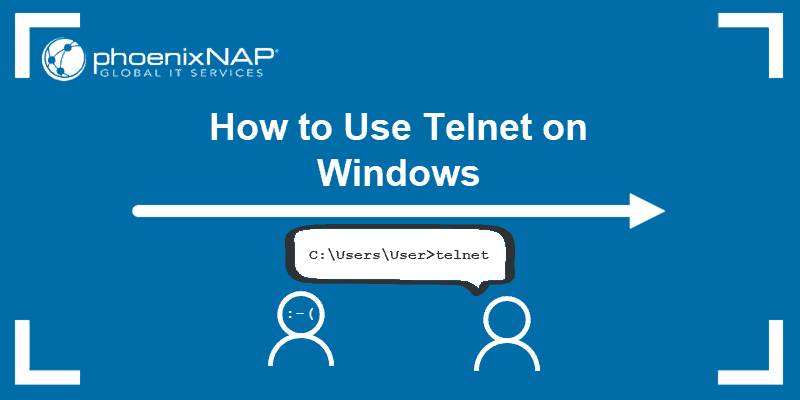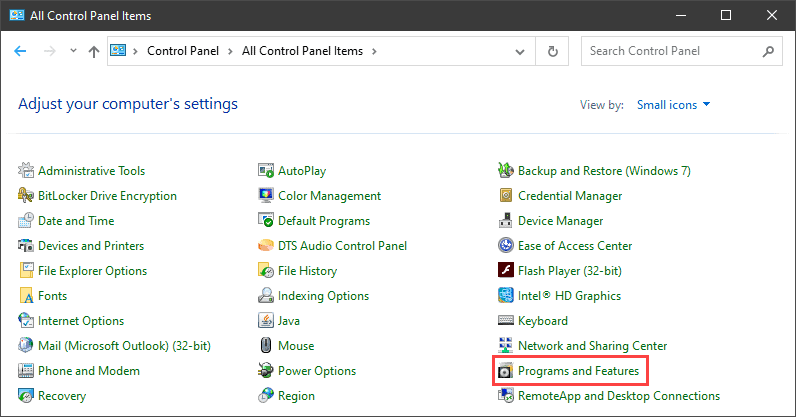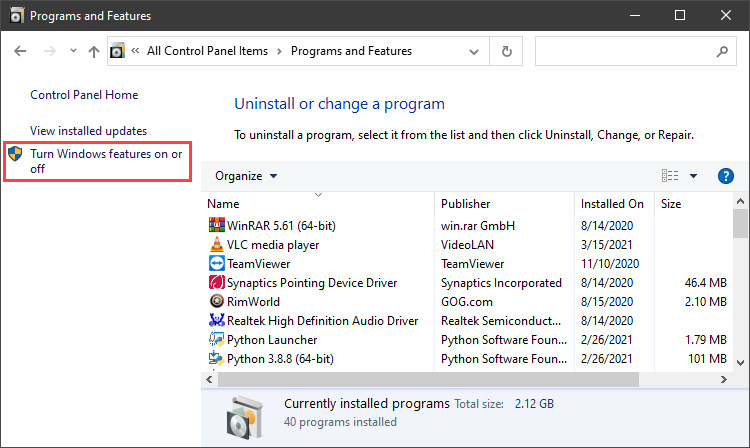На чтение 4 мин Просмотров 51.8к. Опубликовано 29.08.2018
По-умолчанию клиент Telnet клиент в операционных системах Microsoft Windows отключен, чего обычные пользователи вряд ли заметят. Сама возможность включить его в настольных системах присутствует. И поскольку это чрезвычайно полезный инструмент, который можно использовать для тестирования подключения TCP к внешним хостам на указанном порту, то разберемся как активировать данный функционал. Тем, кто дочитает статью до конца, покажу пару интересных вариантов использования команды telnet, о которых многие не догадываются.
Содержание
- Для чего нужен telnet клиент
- Активация Telnet клиента
- Включение клиента telnet с помощью командной строки
- Включение telnet клиент с помощью графического интерфейса
- Проверяем корректно ли установлен telnet клиент
- У вас уже установлен telnet клиент, но все еще не удается подключиться к сетевым ресурсам?
- Превращаем командную строку в web браузер
- Отправка письма из командной строки с помощью telnet
Для чего нужен telnet клиент
Замечательно, когда вы пытаетесь устранить проблемы с сетевыми подключениями, для примера у нас есть веб-сервер, который должен обрабатывать HTTP запросы на 80 порту. Используя telnet для подключения на веб-сервер на порт 80, мы можем проверить возможность подключения, даже когда мы не можем загрузить веб-страницу с помощью браузера.
Возможно, что с подключением все в порядке, но проблема связана с веб-сервером или что веб-сервер остановлен, и, например, порт вообще не прослушивается. С telnet мы можем лучше понять, что происходит.
Активация Telnet клиента
Для начала, нам необходимо включить telnet-клиент. Если не включить, то получим результат, аналогичный приведенному ниже при попытке его использования:
C:UsersMikroTik>telnet google.com 80 "telnet" не является внутренней или внешней командой, исполняемой программой или пакетным файлом.
Вы можете включить клиента либо из командной строки, либо с помощью графического интерфейса.
Включение клиента telnet с помощью командной строки
Запустите команду ниже в командной строке от имени администратора. В противном случае вы получите следующее сообщение системы:
dism /online /Enable-Feature /FeatureName:TelnetClient
Вот и все, через несколько секунд telnet клиент должен быть готов к работе.
Включение telnet клиент с помощью графического интерфейса
Щелкните правой кнопкой мыши на кнопку «Пуск» и выберите «Программы и компоненты».
Выберите «Включение или отключение компонентов Windows» в меню слева.
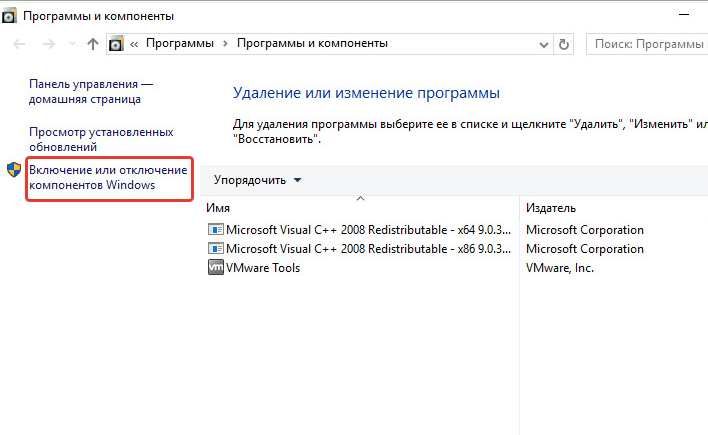
Нажмите кнопку «ОК», на экране отобразится ход установки клиента telnet. Дождитесь момента применения изменений и закройте окно.
Проверяем корректно ли установлен telnet клиент
Просто откроем командную строку или powershell, введем «telnet» и нажмем клавишу «Ввод» на клавиатуре. Если все прошло успешно, то вы получите приглашение, подобное приведенному ниже:
Добро пожаловать в программу-клиент Microsoft Telnet Символ переключения режима: 'CTRL+]' Microsoft Telnet>
У вас уже установлен telnet клиент, но все еще не удается подключиться к сетевым ресурсам?
В некоторых случаях для выполнения команды telent вы должны запускать командную строку cmd или powershell с правами администратора. Иначе получите ошибку аналогичную отсутствующему в системе telnet клиенту.
Превращаем командную строку в web браузер
Возвращаясь к началу статьи, проверим, сможем ли мы подключиться по протоколу HTTP к web серверу google.com на 80 порт:
Появится пустой экран, необходимо ввести запрос «GET /», что равносильно запросу корневой web страницы. Получим следующий ответ от web сервера Google:
Теперь, когда вы включили компоненту telnet в своей системе, сможете сможете использовать данную команды для подключения к сетевым устройствам по различным протоколам.
Отправка письма из командной строки с помощью telnet
Например, при мы можем отправить письмо по SMTP протоколу из командной строки. Для этого введем команду
telnet smtp.mailserver.com 25
Если порт открыт, то получим приглашение от сервера на отправку команд. Нам интересно проверить отправку писем. Будьте внимательны при вводе последовательно следующих команд. Так как опечатки будут приводить к ошибкам, а команды удаления некорректных символов не работают.
- helo имя_вашего_хоста
- mail from: pochta@myhost.ru
- rcpt to: pochta@host.com (если не настроен почтовый relay, будьте внимательны при использовании домена, отличного от поддерживаемого на данном почтовом сервере)
- data
- subject: тема письма
- содержание письма
- . (точка с новой строки означает завершение ввода сообщения)
- quit (выход из сеанса связи)
Таким образом мы использовали telnet для проверки работы сетевых сервисов HTTP и SMTP. Также не забывайте использовать инструмент для устранения неполадок TCP-подключений.
Содержание
- Способ 1: «Программы и компоненты»
- Способ 2: «Командная строка / «Windows PowerShell»»
- Вопросы и ответы
В настоящее время протокол Telnet является устаревшим. Использовать его для удаленного управления компьютером небезопасно, поскольку весь трафик передается в незашифрованном виде. В современных версиях Windows вместо протокола Telnet рекомендуется использовать защищенный протокол SSH.
Способ 1: «Программы и компоненты»
Это самый простой и очевидный способ задействовать компонент «Telnet», предназначенный для удаленного управления компьютером. Чтобы открыть оснастку «Программы и компоненты», сделайте следующее:
- Вызовите нажатием Win + R окошко быстрого выполнения команд, вставьте в него команду
optionalfeaturesи нажмите клавишу ввода. Также открыть оснастку можно через приложение «Параметры», перейдя в раздел «Приложения и возможности» → «Дополнительные компоненты» → «Другие компоненты Windows». - Отыщите в открывшемся окне оснастки пункт «Клиент Telnet», отметьте его флажком и нажмите кнопку «OK».
- Windows 10 выполнит поиск необходимых файлов и установит их.
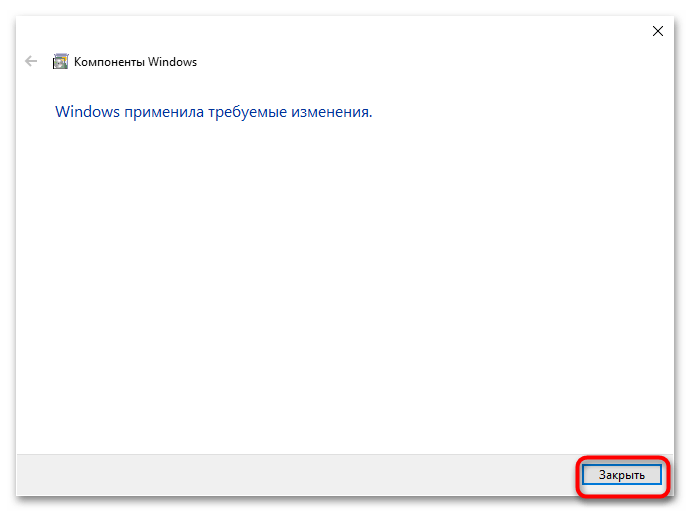
Если Windows попросит перезагрузить компьютер, дайте согласие на перезагрузку.
Способ 2: «Командная строка / «Windows PowerShell»»
Для включения устаревшего клиента «Telnet» можно задействовать классическую «Командную строку» либо же консоль «PowerShell».
- Запустите ту или иную консоль от имени администратора любым удобным вам способом. Например, из контекстного меню кнопки «Пуск».
- Вставьте или введите в консоль команду
dism /online /Enable-Feature /FeatureName:TelnetClientи нажмите клавишу ввода.
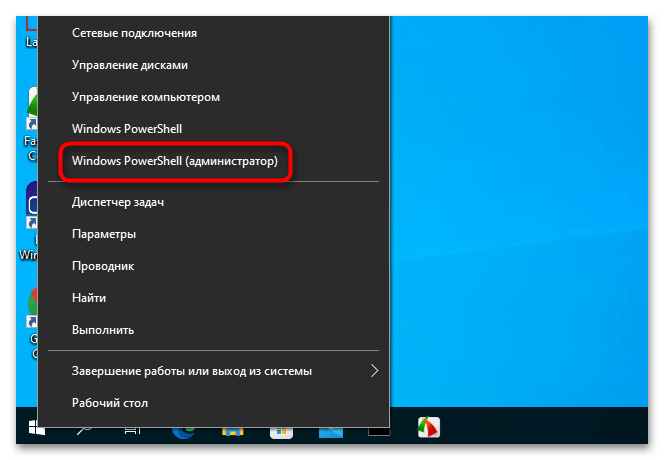
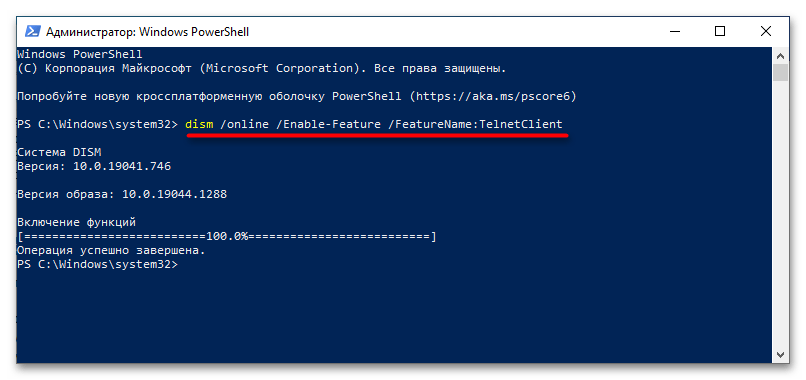
В случае удачного включения компонента команда вернет сообщение «Операция успешно завершена».
Еще статьи по данной теме:
Помогла ли Вам статья?
Table of Contents
- Enabling The Telnet Client
- Verifying The Install
- Summary
- See Also
The Telnet Client is a great tool for developers and administrators to help manage and test network connectivity. However, the Telnet Client application is disabled by default in Microsoft Windows 10. Attempts to use it before activation returns the error
message ’not recognized as an internal or external command, operable program or batch file’.
The following step-by-step shows you how to enable
Telnet.
Enabling The Telnet Client
To enable Telnet Client on Windows 10, follow these steps:
- Right-click the Start button and select Programs and Features.
- Click Turn Windows features on or off from the left-hand menu.
- The Windows Features dialog box appears. Scroll down and select Telnet Client. Click
OK. - The Telnet Client installations begins.
- Once complete, a success message appears.
- Click Close. There’s no need to restart your computer.
Verifying The Install
Once the installation completes, we can use the Telnet Client.
- Launch the Command Prompt by typing Command Prompt into the search box on the menu bar and clicking the app returned.
- Alternatively, you can also type Windows Key + R to open the
Run command dialog. Type cmd and hit the
Enter key. - Type telnet and hit Enter to access the Telnet Client.
- Type help to see the supported Telnet commands.
- Type q or quit to exit Telnet.
- Type telnet google.com 80 to Telnet into Google on port 80.
Summary
In this article, we have seen how to enable and use the Telnet Client in Windows 10.
See Also
- How To Enable Telnet in Windows Server 2012
- Windows 7: Enabling Telnet Client
Telnet is a network protocol that provides a command-line interpreter to communicate with a device. It’s used most often for remote management, but also sometimes for the initial setup for some devices, especially network hardware such as switches and access points.
How Does Telnet Work?
Telnet originally was used on terminals. These computers require only a keyboard because everything on the screen displays as text. The terminal provides a way to remotely log on to another device, just as if you were sitting in front of it and using it like any other computer.
Nowadays, Telnet can be used from a virtual terminal, or a terminal emulator, which is essentially a modern computer that communicates with the same Telnet protocol. One example of this is the telnet command, available from the Command Prompt in Windows that uses the Telnet protocol to communicate with a remote device or system.
Telnet commands can also be executed on other operating systems, such as Linux and macOS, in the same way that they’re executed in Windows.
Telnet isn’t the same as other TCP/IP protocols such as HTTP, which transfers files to and from a server. Instead, the Telnet protocol has you log on to a server as if you were an actual user, then grants you direct control and all the same rights to files and applications as the user that you’re logged in as.
How to Use Windows Telnet
Although Telnet isn’t a secure way to communicate with another device, there are a reason or two to use it, but you can’t just open up a Command Prompt window and expect to start executing commands.
Telnet Client, the command-line tool that executes telnet commands in Windows, works in every version of Windows, but, depending on which version of Windows you’re using, you may have to enable it first.
Enable the Telnet Client in Windows
In Windows 11, Windows 10, Windows 8, Windows 7, and Windows Vista, turn on the Telnet Client in Windows Features in Control Panel before any relevant commands can be executed.
Telnet Client is already installed and ready to use out of the box in both Windows XP and Windows 98.
-
Open Control Panel by searching for control panel in the Start menu. Or, open the Run dialog box via WIN+R and then enter control.
-
Select Programs. If you don’t see that because you’re viewing the Control Panel applet icons, choose Programs and Features instead, and then skip to Step 4.
-
Select Programs and Features.
-
Select Turn Windows features on or off from the left pane.
-
Select the check box next to Telnet Client.
-
Select OK to enable Telnet.
-
When you see the Windows completed the requested changes message, you can close any open dialog boxes.
Execute Telnet Commands in Windows
Telnet commands are easy to execute. After opening Command Prompt, enter the word telnet. The result is a line that says Microsoft Telnet>, which is where commands are entered.
If you don’t plan to follow the first telnet command with additional commands, type telnet followed by any command, such as the ones shown in the examples below.
To connect to a Telnet server, enter a command that follows this syntax:
telnet hostname port
For example, entering telnet textmmode.com 23 connects to textmmode.com on port 23 using Telnet.
The last portion of the command is used for the port number but is only necessary to specify if it’s not the default port of 23. For example, telnet textmmode.com 23 is the same as running the command telnet textmmode.com, but not the same as telnet textmmode.com 95, which connects to the same server but on port 95.
Microsoft keeps a list of telnet commands if you’d like to learn more about how to do things like open and close a Telnet connection, display the Telnet Client settings, and more.
Telnet Games & Additional Information
There are a number of Command Prompt tricks you can perform using Telnet. Some of them are in text form, but you may have fun with them.
Check the weather at Weather Underground :
telnet rainmaker.wunderground.com
Use Telnet to talk to an artificially intelligent psychotherapist named Eliza. After connecting to Telehack with the command below, enter eliza when asked to choose one of the listed commands.
telnet telehack.com
Watch an ASCII version of the full Star Wars Episode IV movie by entering this in Command Prompt:
telnet towel.blinkenlights.nl
Beyond the fun things that can be done in Telnet are a number of Bulletin Board Systems (BBS). A BBS provides a way to message other users, view news, share files, and more. The Telnet BBS Guide lists hundreds of servers that you can connect to using this protocol.
FAQ
-
How is SSH different from Telnet?
SSH is a network protocol used for remote access and uses encryption. Telnet is another network protocol used for remote access but does not use any encryption. It will display data (including usernames and passwords) in clear text.
-
How do I Telnet into my router?
Make sure Telnet is turned on, then ping your network. In Telnet, enter telnet IP address (ex. telnet 192.168.1.10). Next, enter your username and password to log in.
Thanks for letting us know!
Get the Latest Tech News Delivered Every Day
Subscribe
Telnet is a network protocol that provides a command-line interpreter to communicate with a device. It’s used most often for remote management, but also sometimes for the initial setup for some devices, especially network hardware such as switches and access points.
How Does Telnet Work?
Telnet originally was used on terminals. These computers require only a keyboard because everything on the screen displays as text. The terminal provides a way to remotely log on to another device, just as if you were sitting in front of it and using it like any other computer.
Nowadays, Telnet can be used from a virtual terminal, or a terminal emulator, which is essentially a modern computer that communicates with the same Telnet protocol. One example of this is the telnet command, available from the Command Prompt in Windows that uses the Telnet protocol to communicate with a remote device or system.
Telnet commands can also be executed on other operating systems, such as Linux and macOS, in the same way that they’re executed in Windows.
Telnet isn’t the same as other TCP/IP protocols such as HTTP, which transfers files to and from a server. Instead, the Telnet protocol has you log on to a server as if you were an actual user, then grants you direct control and all the same rights to files and applications as the user that you’re logged in as.
How to Use Windows Telnet
Although Telnet isn’t a secure way to communicate with another device, there are a reason or two to use it, but you can’t just open up a Command Prompt window and expect to start executing commands.
Telnet Client, the command-line tool that executes telnet commands in Windows, works in every version of Windows, but, depending on which version of Windows you’re using, you may have to enable it first.
Enable the Telnet Client in Windows
In Windows 11, Windows 10, Windows 8, Windows 7, and Windows Vista, turn on the Telnet Client in Windows Features in Control Panel before any relevant commands can be executed.
Telnet Client is already installed and ready to use out of the box in both Windows XP and Windows 98.
-
Open Control Panel by searching for control panel in the Start menu. Or, open the Run dialog box via WIN+R and then enter control.
-
Select Programs. If you don’t see that because you’re viewing the Control Panel applet icons, choose Programs and Features instead, and then skip to Step 4.
-
Select Programs and Features.
-
Select Turn Windows features on or off from the left pane.
-
Select the check box next to Telnet Client.
-
Select OK to enable Telnet.
-
When you see the Windows completed the requested changes message, you can close any open dialog boxes.
Execute Telnet Commands in Windows
Telnet commands are easy to execute. After opening Command Prompt, enter the word telnet. The result is a line that says Microsoft Telnet>, which is where commands are entered.
If you don’t plan to follow the first telnet command with additional commands, type telnet followed by any command, such as the ones shown in the examples below.
To connect to a Telnet server, enter a command that follows this syntax:
telnet hostname port
For example, entering telnet textmmode.com 23 connects to textmmode.com on port 23 using Telnet.
The last portion of the command is used for the port number but is only necessary to specify if it’s not the default port of 23. For example, telnet textmmode.com 23 is the same as running the command telnet textmmode.com, but not the same as telnet textmmode.com 95, which connects to the same server but on port 95.
Microsoft keeps a list of telnet commands if you’d like to learn more about how to do things like open and close a Telnet connection, display the Telnet Client settings, and more.
Telnet Games & Additional Information
There are a number of Command Prompt tricks you can perform using Telnet. Some of them are in text form, but you may have fun with them.
Check the weather at Weather Underground :
telnet rainmaker.wunderground.com
Use Telnet to talk to an artificially intelligent psychotherapist named Eliza. After connecting to Telehack with the command below, enter eliza when asked to choose one of the listed commands.
telnet telehack.com
Watch an ASCII version of the full Star Wars Episode IV movie by entering this in Command Prompt:
telnet towel.blinkenlights.nl
Beyond the fun things that can be done in Telnet are a number of Bulletin Board Systems (BBS). A BBS provides a way to message other users, view news, share files, and more. The Telnet BBS Guide lists hundreds of servers that you can connect to using this protocol.
FAQ
-
How is SSH different from Telnet?
SSH is a network protocol used for remote access and uses encryption. Telnet is another network protocol used for remote access but does not use any encryption. It will display data (including usernames and passwords) in clear text.
-
How do I Telnet into my router?
Make sure Telnet is turned on, then ping your network. In Telnet, enter telnet IP address (ex. telnet 192.168.1.10). Next, enter your username and password to log in.
Thanks for letting us know!
Get the Latest Tech News Delivered Every Day
Subscribe
Здравствуйте, уважаемые читатели блога. Сегодня решил написать статью, которая полностью будет посвящена довольно — таки распространённому вопросу пользователей — как проводится установка Telnet Windows 10. Прочитав эту статью, вы за несколько минут сможете правильно и без киках — либо проблем установить клиент Telnet на ваш компьютер.
Что такое клиент Телнет?
- Как настроить OpenVPN на Windows 10
- Пропал звук на Windows 10 — испраляем ошибку
- Для чего нужен журнал событий в Windows 10
- Как установить несколько ОС Windows 7 8 10 на одну флешку
- Устраняем критическую ошибку меню «Пуск» на Windows 10
Telnet — достаточно распространённый сетевой протокол, который используется для реализации всего текстового интерфейса по сети при помощи транспорта TCP. Одна из его самых главных задач — это создание идеального взаимодействия между терминальными 
Если говорить простым языком, то данный клиент являет собой простую программу, которая имеет текстовый интерфейс и даёт возможность выполнить быстрое подключение одного компьютера к другому при помощи интернета. Как правило, такой процесс осуществляется при помощи обычной командной строки. Месторасположения программы — диск C, папка Windows System32. А работает клиент примерно таким способом:
Администратор одного из компьютеров даёт разрешение на подключение к нему другого. При включении службы Telnet, она даёт возможность вводить все необходимые команды, использующиеся для доступа к программам и разнообразным службам на удалённом компьютере. Такой софт можно использовать для очень широкого круга процессов: для открытия доступа к электронной почте, баз данных, файлов или других заданий. За умолчанием данный сетевой протокол отключён, но провести его активацию можно быстро и достаточно легко.
Пошаговая инструкция процесса активации продукта
Включение компонентов Windows
- Запустите компьютер;
- Откройте панель управления;
- Найдите вкладку «Программы и компоненты». В левом верхнем углу вкладки, которая откроется выберете пункт «Включение или отключение компонентов Windows».
Активация программного обеспечения
В появившемся списке доступных компонентов выберете папку «Telnet Client» (поставьте птичку возле нужной папки), нажмите «ОК».
ВАЖНО: В некоторых случаях нужно будет подождать одну или даже больше минут, пока произойдет полная установка клиента. Во время этого процесса не нужно думать, что ваш ПК завис и принимать какие — то меры по решению проблемы. Это может привести к ряду ошибок, благодаря которым может потребоваться повторная установка клиента.
Установка службы Телнет через CMD
В случаях, когда вы хотите произвести активацию через командную строку, вам стоит воспользоваться быстрой командой. Для этого:
- В поле «Выполнить «откройте командную строку (наберите команду «cmd»);
- В появившейся строке напечатайте следующую фразу:
start /w pkgmgr /iu:"TelnetClient"Нажмите клавишу «Enter». Через несколько секунд произойдет возврат на начальную командую строку. Чтобы начать пользоваться клиентом Telnet, просто перезагрузите её.
3. Есть еще один способ, но для этого нам понадобятся права администратора. Запускаем консоль с правами админа и вводим следующую команду:
dism /online /Enable-Feature /FeatureName:TelnetClient
Как включить и начать пользоваться программой?
Для начала откройте командную строку. Не стоит забывать, что сетевой протокол Telnet теперь запускается через командную строку. Чтобы совершить действие просто нажмите на клавишу «Win» и введите команду «Cmd» в поле «Выполнить». Далее наберите фразу «Telnet» и нажмите «Enter». Если всё было сделано верно, командная строка должна исчезнуть, вместо неё запустится линия Telnet, которая должна иметь примерно такой вид — «Microsoft Telnet».
Следующий этап — подключение к серверу. Как включить Telnet Windows 10?
В командной строке без ошибок введите команду:
open serveraddress [port]
При успешном завершении операции перед вами откроется окно запроса имени пользователя и пароля. После удачного подключение и пользования сервисом, всё, что осталось сделать — это правильно завершить сессию: откройте командную строку, пропишите в ней слово «quit» и нажмите «Enter».
Клиент запущен и доступен для пользования абсолютно бесплатно. Практически все доступные команды для пользования данным сетевым протокол можно скачать в интернете (close, display, set, st и другие).
Видео как установить Telnet
На этом хотел бы попрощаться с вами и завершить сегодняшнею статью. Чтобы решить раз и навсегда проблему с Telnet Windows 7 / 8 /10, весь текст разбил на детально разобранные пункты. Поэтому, очень надеюсь, что текст вам поможет и не вызовет никаких вопросов. Буду очень благодарен за подписку на мой блог и репост в социальных сетях.
С уважением, Виктор

Содержание
- Способ 1: «Программы и компоненты»
- Способ 2: «Командная строка / «Windows PowerShell»»
- Вопросы и ответы
В настоящее время протокол Telnet является устаревшим. Использовать его для удаленного управления компьютером небезопасно, поскольку весь трафик передается в незашифрованном виде. В современных версиях Windows вместо протокола Telnet рекомендуется использовать защищенный протокол SSH.
Способ 1: «Программы и компоненты»
Это самый простой и очевидный способ задействовать компонент «Telnet», предназначенный для удаленного управления компьютером. Чтобы открыть оснастку «Программы и компоненты», сделайте следующее:
- Вызовите нажатием Win + R окошко быстрого выполнения команд, вставьте в него команду
optionalfeaturesи нажмите клавишу ввода. Также открыть оснастку можно через приложение «Параметры», перейдя в раздел «Приложения и возможности» → «Дополнительные компоненты» → «Другие компоненты Windows». - Отыщите в открывшемся окне оснастки пункт «Клиент Telnet», отметьте его флажком и нажмите кнопку «OK».
- Windows 10 выполнит поиск необходимых файлов и установит их.

Если Windows попросит перезагрузить компьютер, дайте согласие на перезагрузку.
Способ 2: «Командная строка / «Windows PowerShell»»
Для включения устаревшего клиента «Telnet» можно задействовать классическую «Командную строку» либо же консоль «PowerShell».
- Запустите ту или иную консоль от имени администратора любым удобным вам способом. Например, из контекстного меню кнопки «Пуск».
- Вставьте или введите в консоль команду
dism /online /Enable-Feature /FeatureName:TelnetClientи нажмите клавишу ввода.


В случае удачного включения компонента команда вернет сообщение «Операция успешно завершена».
Еще статьи по данной теме:
Помогла ли Вам статья?
В данной статье показаны действия, с помощью которых можно включить компонент Telnet Client в операционной системе Windows 10, Windows 8.1 и Windows 7.
Telnet (teletype network) — сетевой протокол с помощью которого можно удаленно (через интернет или локальную сеть) подключиться и управлять различными сетевыми устройствами, например удаленные компьютеры, серверы, роутеры и другие устройства.
По умолчанию компонент Telnet Client в операционных системах Windows 10, Windows 8.1 и Windows 7 отключён, но при необходимости можно легко включить его используя любой из способов, которые представлены далее в этой инструкции.
Содержание
- Включение Telnet Client в окне «Компоненты Windows»
- Активация в командной строке
- Включение через Windows PowerShell
Включение Telnet Client в окне «Компоненты Windows»
Чтобы включить компонент Telnet Client, нажмите сочетание клавиш + R, в открывшемся окне Выполнить введите (скопируйте и вставьте) OptionalFeatures и нажмите клавишу Enter↵.
В открывшемся окне «Компоненты Windows» установите флажок компонента Telnet Client и нажмите кнопку OK.
Через непродолжительное время Windows применит требуемые изменения и компонент Telnet Client будет включен.
Активация в командной строке
Вы можете включить или отключить компонент Telnet Client в командной строке используя DISM
Чтобы включить компонент Telnet Client, запустите командную строку от имени администратора и выполните следующую команду:
Dism /online /Enable-Feature /FeatureName:TelnetClient
Чтобы отключить компонент Telnet Client, запустите командную строку от имени администратора и выполните следующую команду:
Dism /online /Disable-Feature /FeatureName:TelnetClient
Включение через Windows PowerShell
Также включить или отключить компонент Telnet Client можно в консоли PowerShell
Чтобы включить компонент Telnet Client, откройте консоль Windows PowerShell от имени администратора и выполните следующую команду:
Enable-WindowsOptionalFeature –FeatureName «TelnetClient» -Online
Чтобы отключить компонент Telnet Client, откройте консоль Windows PowerShell от имени администратора и выполните следующую команду:
Disable-WindowsOptionalFeature –FeatureName «TelnetClient» -Online
После включения компонента Telnet Client можно использовать утилиту telnet для выполнения необходимых задач.
Если компонент Telnet Client отключен, то при вводе команды telnet в консоли командной строки вы увидите сообщение о том что:
«telnet» не является внутренней или внешней
командой, исполняемой программой или пакетным файлом.
Используя рассмотренные выше действия, можно включить или отключить компонент Telnet Client в операционной системе Windows 10, Windows 8.1 и Windows 7
Telnet — это протокол удаленного доступа, обычно используемый в системах Windows, но его также можно установить на Mac и Linux с помощью Homebrew. Этот протокол довольно старый и больше не используется. Протокол используется в командной строке. Со времени создания Telnet были разработаны более совершенные инструменты, которые имеют более интуитивно понятный графический интерфейс.
Telnet не устарел. Он все еще работает, но не многие люди его используют. Существуют клиенты с графическим интерфейсом, которые используют Telnet, что значительно упрощает его использование, но, несмотря на это, вы обнаружите, что существуют более эффективные решения для удаленного доступа. Тем не менее, вы все равно можете включить и использовать Telnet в Windows 10.
Включение Telnet в Windows 10 — Панель управления
Чтобы включить Telnet в Windows 10, выполните следующие действия.
Откройте Панель управления.
Зайдите в «Программы».
Выберите Включение или отключение компонентов Windows.
В открывшемся окне выберите Telnet Client.
Нажмите ОК и следуйте инструкциям на экране для установки клиента.
Включение Telnet в Windows 10 — командная строка
Вы можете включить Telnet в Windows 10 через командную строку.
Откройте командную строку с правами администратора.
Выполните эту команду: DISM / online / Enable-Feature / FeatureName: TelnetClient
Когда команда завершится, клиент Telnet будет установлен в вашей системе.
Включение Telnet в Windows 10 — PowerShell
Чтобы включить Telnet из PowerShell, выполните следующие действия.
Откройте PowerShell с правами администратора.
Выполните эту команду: Install-WindowsFeature -name Telnet-Client
Клиент Telnet будет установлен.
Подтвердите установку Telnet
Чтобы проверить, установлен ли Telnet в вашей системе, или убедиться, что установка прошла успешно, выполните следующие действия.
Откройте командную строку с правами администратора.
Выполните эту команду: telnet
Вы должны увидеть сообщение «Microsoft Telnet». Если команда не распознается, Telnet не установлен.
Как использовать Telnet в Windows 10
Клиент Telnet — это инструмент командной строки. Он не будет устанавливаться как приложение с графическим интерфейсом, и вы будете использовать его через командную строку. Ты должен быть знаком с командами для подключения к удаленной системе. Откройте командную строку с правами администратора.
Подключиться к серверу
telnet hostname port
Заключение
Если вам необходимо получить удаленный доступ к системе, отличной от Windows, telnet может быть достаточно хорошим решением, однако вы должны знать порт и IP-адрес, а также имя пользователя и пароль для системы, к которой вы подключаетесь. Система также должна быть настроена на прием и разрешение соединения от Telnet. Все это становится немного утомительным, поэтому есть инструменты, которые намного проще в использовании и которые являются кроссплатформенными.
Что вы думаете об этой статье?
Table of Contents
- Enabling The Telnet Client
- Verifying The Install
- Summary
- See Also
The Telnet Client is a great tool for developers and administrators to help manage and test network connectivity. However, the Telnet Client application is disabled by default in Microsoft Windows 10. Attempts to use it before activation returns the error
message ’not recognized as an internal or external command, operable program or batch file’.
The following step-by-step shows you how to enable
Telnet.
Enabling The Telnet Client
To enable Telnet Client on Windows 10, follow these steps:
- Right-click the Start button and select Programs and Features.
- Click Turn Windows features on or off from the left-hand menu.
- The Windows Features dialog box appears. Scroll down and select Telnet Client. Click
OK. - The Telnet Client installations begins.
- Once complete, a success message appears.
- Click Close. There’s no need to restart your computer.
Verifying The Install
Once the installation completes, we can use the Telnet Client.
- Launch the Command Prompt by typing Command Prompt into the search box on the menu bar and clicking the app returned.
- Alternatively, you can also type Windows Key + R to open the
Run command dialog. Type cmd and hit the
Enter key. - Type telnet and hit Enter to access the Telnet Client.
- Type help to see the supported Telnet commands.
- Type q or quit to exit Telnet.
- Type telnet google.com 80 to Telnet into Google on port 80.
Summary
In this article, we have seen how to enable and use the Telnet Client in Windows 10.
See Also
- How To Enable Telnet in Windows Server 2012
- Windows 7: Enabling Telnet Client
Introduction
Telnet (teletype network) is a network protocol for two-way text-based communication through a CLI, allowing remote access. Telnet is vulnerable to cybersecurity attacks because it lacks encryption methods compared to the more modern SSH. However, it is still helpful for tasks that do not involve transmitting sensitive information.
This article teaches you what Telnet is as well as how to use Telnet on Windows to test for open ports.
Prerequisites
- Windows OS with administrator privileges
- Access to the command prompt
- An address and port to test
What is Telnet?
Telnet is a client-server protocol predating the TCP protocol. The network protocol allows a user to log into another computer within the same network through a TCP/IP connection.
A client machine running the Telnet client connects to a CLI on a remote device, most commonly a dedicated platform. Telnet is lightweight and fast, making it the preferred option in some use cases:
- Initial network hardware configuration.
- Remote access to trusted internal networks.
- Testing for open or used ports.
- Troubleshooting mail and web servers.
- Checking port forwarding.
How Does Telnet Work?
The Telnet protocol creates a communication path through a virtual terminal connection. The data distributes in-band with Telnet control information over the transmission control protocol (TCP).
Unlike other TCP/IP protocols, Telnet provides a log-in screen and allows logging in as the remote device’s actual user when establishing a connection on port 23. This type of access grants direct control with all the same privileges as the owner of the credentials.
Telnet comes with a command accessible from the command line in Windows. The telnet command also exists for macOS and Linux operating systems.
How to Enable Telnet on Windows 10?
In Windows systems, Telnet is disabled by default. To check if Telnet is already activated, open your command line, and run telnet:
If the command prompt does not recognize the command, there are two possible ways to enable the Telnet client in Windows.
Option 1: Enable Telnet using GUI
To activate the Telnet command using the GUI:
1. Open the Programs and Features options in Control Panel:
2. Click the Turn Windows features on or off setting:
3. Locate the Telnet Client option on the list, select it and click OK to install the feature:
4. When Windows completes the requested change, click Close.
5. Open the command prompt and run telnet to open the Microsoft Telnet Client:
6. Run quit to exit the Telnet client.
Option 2: Enable Telnet Using Command Prompt
To activate the Telnet client from the command prompt:
1. In the command prompt, run:
pkgmgr /iu:"TelnetClient"2. Restart the command prompt and run telnet to open the Microsoft Telnet Client.
3. Run quit to exit the client:
How to Use Telnet in Windows to Test Open Ports
The Telnet syntax for testing open ports is:
telnet <address> <port number>The command accepts both symbolic and numeric addresses. For example:
telnet towel.blinkenlights.nl 23Or alternatively:
telnet 127.0.0.1 80After running the command, one of the following three options happen:
1. The command throws an error, indicating the port is not available for connection:
2. The command goes to a blank screen, indicating the port is available.
3. Running the command on an open port 23 displays the screen of the telnet host, confirming an established Telnet connection:
Note: Learn how Telnet differs from SSH in our comparison article Telnet vs SSH.
Conclusion
The Telnet communication protocol provides a way to establish a direct connection with a remote host. Although not a secure option for most tasks, there are use cases where Telnet is a viable option.
For further reading, check out the more secure option and learn how to use SSH to connect to a remote server in Linux or Windows.
Здравствуйте, уважаемые читатели блога. Сегодня решил написать статью, которая полностью будет посвящена довольно — таки распространённому вопросу пользователей — как проводится установка Telnet Windows 10. Прочитав эту статью, вы за несколько минут сможете правильно и без киках — либо проблем установить клиент Telnet на ваш компьютер.
Что такое клиент Телнет?
- Как настроить OpenVPN на Windows 10
- Пропал звук на Windows 10 — испраляем ошибку
- Для чего нужен журнал событий в Windows 10
- Как установить несколько ОС Windows 7 8 10 на одну флешку
- Устраняем критическую ошибку меню «Пуск» на Windows 10
Telnet — достаточно распространённый сетевой протокол, который используется для реализации всего текстового интерфейса по сети при помощи транспорта TCP. Одна из его самых главных задач — это создание идеального взаимодействия между терминальными 
Если говорить простым языком, то данный клиент являет собой простую программу, которая имеет текстовый интерфейс и даёт возможность выполнить быстрое подключение одного компьютера к другому при помощи интернета. Как правило, такой процесс осуществляется при помощи обычной командной строки. Месторасположения программы — диск C, папка Windows System32. А работает клиент примерно таким способом:
Администратор одного из компьютеров даёт разрешение на подключение к нему другого. При включении службы Telnet, она даёт возможность вводить все необходимые команды, использующиеся для доступа к программам и разнообразным службам на удалённом компьютере. Такой софт можно использовать для очень широкого круга процессов: для открытия доступа к электронной почте, баз данных, файлов или других заданий. За умолчанием данный сетевой протокол отключён, но провести его активацию можно быстро и достаточно легко.
Пошаговая инструкция процесса активации продукта
- Запустите компьютер;
- Откройте панель управления;
- Найдите вкладку «Программы и компоненты». В левом верхнем углу вкладки, которая откроется выберете пункт «Включение или отключение компонентов Windows».
Активация программного обеспечения
В появившемся списке доступных компонентов выберете папку «Telnet Client» (поставьте птичку возле нужной папки), нажмите «ОК».
ВАЖНО: В некоторых случаях нужно будет подождать одну или даже больше минут, пока произойдет полная установка клиента. Во время этого процесса не нужно думать, что ваш ПК завис и принимать какие — то меры по решению проблемы. Это может привести к ряду ошибок, благодаря которым может потребоваться повторная установка клиента.
Установка службы Телнет через CMD
В случаях, когда вы хотите произвести активацию через командную строку, вам стоит воспользоваться быстрой командой. Для этого:
- В поле «Выполнить «откройте командную строку (наберите команду «cmd»);
- В появившейся строке напечатайте следующую фразу:
start /w pkgmgr /iu:"TelnetClient"Нажмите клавишу «Enter». Через несколько секунд произойдет возврат на начальную командую строку. Чтобы начать пользоваться клиентом Telnet, просто перезагрузите её.
3. Есть еще один способ, но для этого нам понадобятся права администратора. Запускаем консоль с правами админа и вводим следующую команду:
dism /online /Enable-Feature /FeatureName:TelnetClient
Как включить и начать пользоваться программой?
Для начала откройте командную строку. Не стоит забывать, что сетевой протокол Telnet теперь запускается через командную строку. Чтобы совершить действие просто нажмите на клавишу «Win» и введите команду «Cmd» в поле «Выполнить». Далее наберите фразу «Telnet» и нажмите «Enter». Если всё было сделано верно, командная строка должна исчезнуть, вместо неё запустится линия Telnet, которая должна иметь примерно такой вид — «Microsoft Telnet».
Следующий этап — подключение к серверу. Как включить Telnet Windows 10?
В командной строке без ошибок введите команду:
open serveraddress [port]
При успешном завершении операции перед вами откроется окно запроса имени пользователя и пароля. После удачного подключение и пользования сервисом, всё, что осталось сделать — это правильно завершить сессию: откройте командную строку, пропишите в ней слово «quit» и нажмите «Enter».
Клиент запущен и доступен для пользования абсолютно бесплатно. Практически все доступные команды для пользования данным сетевым протокол можно скачать в интернете (close, display, set, st и другие).
Видео как установить Telnet
На этом хотел бы попрощаться с вами и завершить сегодняшнею статью. Чтобы решить раз и навсегда проблему с Telnet Windows 7 / 8 /10, весь текст разбил на детально разобранные пункты. Поэтому, очень надеюсь, что текст вам поможет и не вызовет никаких вопросов. Буду очень благодарен за подписку на мой блог и репост в социальных сетях.
С уважением, Виктор
As you may have already discovered, in Windows 10, the Telnet command, «is not recognized as an internal or external command, operable program or batch file». This is happening, because the Telnet client, which is a very useful tool for administrators to verify and test the network connectivity, is disabled by default in Windows 10.
In this tutorial you ‘ll find all the available ways to enable the ‘Telnet’ command in Windows 10 in order to resolve the error «telnet is not recognized as an internal or external command, operable program or batch file».
How to Turn On Telnet Client in Windows 10.
Method 1. Enable Telnet Client from Programs & Features.
Method 2. Enable Telnet Client from Command Prompt.
Method 3. Enable Telnet client from PowerShell or Command Prompt using DISM.
Method 1. How to Enable Telnet Client from Programs & Features.
1. Open Programs and features in Control Panel.
2. Click Turn Windows features on or off, on the left.
3. Select the Telnet Client and click OK.
4. Let Windows to install the required files for the Telnet client.
5. When the installation in completed, click Close, any you’re done!
Method 2. How to Install Telnet Client from Command Prompt in Windows 10.
To enable the Telnet client from command prompt in Windows 10:
1. Open Command Prompt as Administrator. To do that:
1. At the search box type: command prompt or cmd
2. Right-click at Command Prompt result and select Run As Administrator.
2. In command prompt, paste the below command and press Enter.
- pkgmgr /iu:”TelnetClient”
Method 3. How Add Telnet Client feature from PowerShell in Windows 10.
1. Open PowerShell (or Command Prompt) as Administrator. To open PowerShell as administrator:
1. At the search box type: powershell
2. Right click on Windows PowerShell on the results and select Run as administrator.
3. In PowerShell, give the following command to enable the Telnet client:
-
dism /online /Enable-Feature /FeatureName:TelnetClient
That’s it! Let me know if this guide has helped you by leaving your comment about your experience. Please like and share this guide to help others.
If this article was useful for you, please consider supporting us by making a donation. Even $1 can a make a huge difference for us in our effort to continue to help others while keeping this site free:

If you want to stay constantly protected from malware threats, existing and future ones, we recommend that you install Malwarebytes Anti-Malware PRO by clicking below (we
do earn a commision from sales generated from this link, but at no additional cost to you. We have experience with this software and we recommend it because it is helpful and useful):
Full household PC Protection — Protect up to 3 PCs with NEW Malwarebytes Anti-Malware Premium!
Telnet is a network protocol that provides a command-line interpreter to communicate with a device. It’s used most often for remote management, but also sometimes for the initial setup for some devices, especially network hardware such as switches and access points.
How Does Telnet Work?
Telnet originally was used on terminals. These computers require only a keyboard because everything on the screen displays as text. The terminal provides a way to remotely log on to another device, just as if you were sitting in front of it and using it like any other computer.
Nowadays, Telnet can be used from a virtual terminal, or a terminal emulator, which is essentially a modern computer that communicates with the same Telnet protocol. One example of this is the telnet command, available from the Command Prompt in Windows that uses the Telnet protocol to communicate with a remote device or system.
Telnet commands can also be executed on other operating systems, such as Linux and macOS, in the same way that they’re executed in Windows.
Telnet isn’t the same as other TCP/IP protocols such as HTTP, which transfers files to and from a server. Instead, the Telnet protocol has you log on to a server as if you were an actual user, then grants you direct control and all the same rights to files and applications as the user that you’re logged in as.
How to Use Windows Telnet
Although Telnet isn’t a secure way to communicate with another device, there are a reason or two to use it, but you can’t just open up a Command Prompt window and expect to start executing commands.
Telnet Client, the command-line tool that executes telnet commands in Windows, works in every version of Windows, but, depending on which version of Windows you’re using, you may have to enable it first.
Enable the Telnet Client in Windows
In Windows 11, Windows 10, Windows 8, Windows 7, and Windows Vista, turn on the Telnet Client in Windows Features in Control Panel before any relevant commands can be executed.
Telnet Client is already installed and ready to use out of the box in both Windows XP and Windows 98.
-
Open Control Panel by searching for control panel in the Start menu. Or, open the Run dialog box via WIN+R and then enter control.
-
Select Programs. If you don’t see that because you’re viewing the Control Panel applet icons, choose Programs and Features instead, and then skip to Step 4.
-
Select Programs and Features.
-
Select Turn Windows features on or off from the left pane.
-
Select the check box next to Telnet Client.
-
Select OK to enable Telnet.
-
When you see the Windows completed the requested changes message, you can close any open dialog boxes.
Execute Telnet Commands in Windows
Telnet commands are easy to execute. After opening Command Prompt, enter the word telnet. The result is a line that says Microsoft Telnet>, which is where commands are entered.
If you don’t plan to follow the first telnet command with additional commands, type telnet followed by any command, such as the ones shown in the examples below.
To connect to a Telnet server, enter a command that follows this syntax:
telnet hostname port
For example, entering telnet textmmode.com 23 connects to textmmode.com on port 23 using Telnet.
The last portion of the command is used for the port number but is only necessary to specify if it’s not the default port of 23. For example, telnet textmmode.com 23 is the same as running the command telnet textmmode.com, but not the same as telnet textmmode.com 95, which connects to the same server but on port 95.
Microsoft keeps a list of telnet commands if you’d like to learn more about how to do things like open and close a Telnet connection, display the Telnet Client settings, and more.
Telnet Games & Additional Information
There are a number of Command Prompt tricks you can perform using Telnet. Some of them are in text form, but you may have fun with them.
Check the weather at Weather Underground :
telnet rainmaker.wunderground.com
Use Telnet to talk to an artificially intelligent psychotherapist named Eliza. After connecting to Telehack with the command below, enter eliza when asked to choose one of the listed commands.
telnet telehack.com
Watch an ASCII version of the full Star Wars Episode IV movie by entering this in Command Prompt:
telnet towel.blinkenlights.nl
Beyond the fun things that can be done in Telnet are a number of Bulletin Board Systems (BBS). A BBS provides a way to message other users, view news, share files, and more. The Telnet BBS Guide lists hundreds of servers that you can connect to using this protocol.
FAQ
-
How is SSH different from Telnet?
SSH is a network protocol used for remote access and uses encryption. Telnet is another network protocol used for remote access but does not use any encryption. It will display data (including usernames and passwords) in clear text.
-
How do I Telnet into my router?
Make sure Telnet is turned on, then ping your network. In Telnet, enter telnet IP address (ex. telnet 192.168.1.10). Next, enter your username and password to log in.
Thanks for letting us know!
Get the Latest Tech News Delivered Every Day
Subscribe
Telnet is a network protocol that provides a command-line interpreter to communicate with a device. It’s used most often for remote management, but also sometimes for the initial setup for some devices, especially network hardware such as switches and access points.
How Does Telnet Work?
Telnet originally was used on terminals. These computers require only a keyboard because everything on the screen displays as text. The terminal provides a way to remotely log on to another device, just as if you were sitting in front of it and using it like any other computer.
Nowadays, Telnet can be used from a virtual terminal, or a terminal emulator, which is essentially a modern computer that communicates with the same Telnet protocol. One example of this is the telnet command, available from the Command Prompt in Windows that uses the Telnet protocol to communicate with a remote device or system.
Telnet commands can also be executed on other operating systems, such as Linux and macOS, in the same way that they’re executed in Windows.
Telnet isn’t the same as other TCP/IP protocols such as HTTP, which transfers files to and from a server. Instead, the Telnet protocol has you log on to a server as if you were an actual user, then grants you direct control and all the same rights to files and applications as the user that you’re logged in as.
How to Use Windows Telnet
Although Telnet isn’t a secure way to communicate with another device, there are a reason or two to use it, but you can’t just open up a Command Prompt window and expect to start executing commands.
Telnet Client, the command-line tool that executes telnet commands in Windows, works in every version of Windows, but, depending on which version of Windows you’re using, you may have to enable it first.
Enable the Telnet Client in Windows
In Windows 11, Windows 10, Windows 8, Windows 7, and Windows Vista, turn on the Telnet Client in Windows Features in Control Panel before any relevant commands can be executed.
Telnet Client is already installed and ready to use out of the box in both Windows XP and Windows 98.
-
Open Control Panel by searching for control panel in the Start menu. Or, open the Run dialog box via WIN+R and then enter control.
-
Select Programs. If you don’t see that because you’re viewing the Control Panel applet icons, choose Programs and Features instead, and then skip to Step 4.
-
Select Programs and Features.
-
Select Turn Windows features on or off from the left pane.
-
Select the check box next to Telnet Client.
-
Select OK to enable Telnet.
-
When you see the Windows completed the requested changes message, you can close any open dialog boxes.
Execute Telnet Commands in Windows
Telnet commands are easy to execute. After opening Command Prompt, enter the word telnet. The result is a line that says Microsoft Telnet>, which is where commands are entered.
If you don’t plan to follow the first telnet command with additional commands, type telnet followed by any command, such as the ones shown in the examples below.
To connect to a Telnet server, enter a command that follows this syntax:
telnet hostname port
For example, entering telnet textmmode.com 23 connects to textmmode.com on port 23 using Telnet.
The last portion of the command is used for the port number but is only necessary to specify if it’s not the default port of 23. For example, telnet textmmode.com 23 is the same as running the command telnet textmmode.com, but not the same as telnet textmmode.com 95, which connects to the same server but on port 95.
Microsoft keeps a list of telnet commands if you’d like to learn more about how to do things like open and close a Telnet connection, display the Telnet Client settings, and more.
Telnet Games & Additional Information
There are a number of Command Prompt tricks you can perform using Telnet. Some of them are in text form, but you may have fun with them.
Check the weather at Weather Underground :
telnet rainmaker.wunderground.com
Use Telnet to talk to an artificially intelligent psychotherapist named Eliza. After connecting to Telehack with the command below, enter eliza when asked to choose one of the listed commands.
telnet telehack.com
Watch an ASCII version of the full Star Wars Episode IV movie by entering this in Command Prompt:
telnet towel.blinkenlights.nl
Beyond the fun things that can be done in Telnet are a number of Bulletin Board Systems (BBS). A BBS provides a way to message other users, view news, share files, and more. The Telnet BBS Guide lists hundreds of servers that you can connect to using this protocol.
FAQ
-
How is SSH different from Telnet?
SSH is a network protocol used for remote access and uses encryption. Telnet is another network protocol used for remote access but does not use any encryption. It will display data (including usernames and passwords) in clear text.
-
How do I Telnet into my router?
Make sure Telnet is turned on, then ping your network. In Telnet, enter telnet IP address (ex. telnet 192.168.1.10). Next, enter your username and password to log in.
Thanks for letting us know!
Get the Latest Tech News Delivered Every Day
Subscribe




